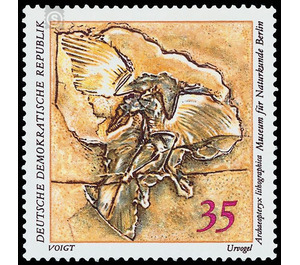Paleontological collections from the Museum of Natural History in Berlin - Germany / German Democratic Republic 1973 - 35 Pfennig
Theme: Architecture
| Country | Germany / German Democratic Republic |
| Issue Date | 1973 |
| Face Value | 35.00 |
| Color | brown |
| Perforation | K 13 |
| Printing Type | Photogravure |
| Stamp Type | Postage stamp |
| Item Type | Stamp |
| Chronological Issue Number | 1568 |
| Chronological Chapter | GER-DDR |
| SID | 203045 |
| In 25 Wishlists | |
Paleontological collections from the Museum of Natural History in Berlin The Ministry of Posts and Telecommunications of the German Democratic Republic publishes six multicolored special postage stamps depicting motifs of paleontological collections from the Museum of Natural History in Berlin. Paleontological collections from the Museum of Natural History Berlin The fossils from the paleontological collections of the Museum of Natural History Berlin on the special stamps are particularly valuable original witnesses of the history of life on earth. They are both research objects and simultaneously used illustrative material in the educational work of the museum. The Museum of Natural History Berlin - an institution of the Humboldt University - preserves, maintains and extends, among other natural history collections, the largest paleontological collection of the GDR with about 15 million objects. 35-pfennig value: primitive bird, Archeopteryx lithographica; H. v. MEYER The "primeval bird" Archeopteryx is arguably the most famous fossil, as it represents a link between two vertebrate classes, the reptiles and the birds, one of the most significant evidence for the theory of evolution and evolution. The 1877 found "Berliner Exemplar" from the Solnhofen plate limestone of the upper Jurassic is also the best-conserving of the few finds so far known. Although feathers, as the most important new feature, characterize Archeopteryx as a bird, the reptile traits, eg. B. the dentate jaw, consisting of free vertebrae long tail and the claws on the front limbs.


